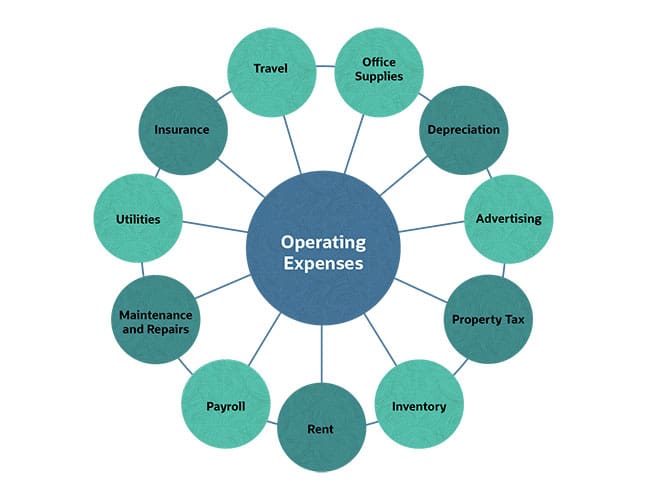Understanding how much money it takes to keep a company running is critical to the viability of all organizations. As operating expenditures increase, profitability decreases. Therefore, by being aware of and proactively mitigating the cost of operations, businesses have the potential to better control costs and improve their financial health.
What Are Operating Expenses?
Operating costs are expenditures directly related to day-to-day business activities, excluding the processes involved in manufacturing a product or delivering a service. Examples include rent, travel, utilities, salaries, office supplies, maintenance and repairs, property taxes and depreciation (see below for a more comprehensive list).
Operating vs. Non-Operating Expenses
A company’s operating expenses, sometimes called OpEx, are reflected in its income statement. Along with non-operating expenses, they help businesses calculate their profitability. Non-OpEx are expenditures indirectly related to operations that are the result of financing or investing activities, like interest payments on loans.
Operating (and non-operating) expenses can be fixed — unaffected by changes in production volume or service delivery — or variable, meaning they fluctuate in proportion to the changes in volume or delivery. While rent and salaries are examples of fixed OpEx, fuel and sales commissions are variable ones.
Operating Expenses vs. COGS
Operating expenses are different from the cost of goods sold (COGS), which are the direct expenses a business pays to purchase or manufacture its products. COGS can be difficult to calculate depending on the complexity of the business and what it sells. In the simplest of terms, COGS include the beginning inventory plus inventory purchases minus the ending inventory. This formula includes the cost of purchasing the items, inbound freight, manufacturing (including labor), modification and packaging.
Capital Expenses vs. Operating Expenses
Unlike COGS and OpEx, capital expenses do not show up on the company’s income statement. Capital expenses, or CapEx, are one-time expenditures of tangible or nontangible assets that are reflected on a company’s balance sheet. These assets usually have a lifespan of one year or more and bring longer-term value to the business.
While capital expenditures are deductible, the deduction occurs over a period of time, rather than immediately. Those deductions happen through processes called depreciation and amortization. Note: In some cases, for certain asset categories, 100% first-year depreciation is allowed.
Key Takeaways
- Every organization has operating expenses that come with running a business and make it possible to sell goods or services.
- Compiling these costs helps organizations measure profitability and related numbers, like operating profit margin.
- By keeping a close eye on operating expenses, finance teams can identify outliers and trends that could reveal opportunities to reduce expenses without sacrificing product or service quality.
- Accounting software makes it much easier to calculate and track operating expenses and related metrics.
Operating Expense Explained
Having a clear picture of OpEx, COGS and non-OpEx is crucial to figuring out whether your business is profitable. There is no hard-and-fast rule on the ideal percentage of operating costs relative to revenue. It will differ depending on the business model, industry and the business’s maturity. But as a general rule, keeping operating costs under control and selling more of your products or services creates more free cash flow for the business, which is a good thing.
What Are Operational Activities?
Operating costs are the result of a company’s operating activities, or activities directly related to selling products or services to customers. Employee travel, marketing campaigns and repair of key equipment are all examples of operational activities.
On the cash flow statement, operating cash flow measures the cash coming into and out of the business from these operating activities. Cash comes in, for instance, from the sale of goods or services, and cash flows out to pay employees. Other classifications on the cash flow statement, like investing and financing activities, are considered non-OpEx.
What Is Included in Operating Expenses?
Operating costs, which include many of the expenses necessary to keep a business on its feet, consist of a wide array of expense categories. Here are 11 examples of these expenditures, which are related to various areas of a business’s core operations:
-
Office Supplies. These are items that are consistently used by office staff or require regular replenishment such as printer paper, invoices and sales receipts, staplers, pens, janitorial cleaning supplies and USB flash drives.
-
Depreciation. This refers to fixed assets bought by a company that depreciate in value over time. Assets that depreciate include warehouse equipment and machinery, furniture, computer equipment, delivery vehicles, buildings and store displays.
-
Advertising. Advertising includes any money spent on marketing the company. For example, business cards, social media, brochures, websites, and TV, print and digital campaigns.
-
Property Tax. These are real estate taxes that vary based on the assessed value of a property.
-
Inventory. Any expenses related to ordering and storing inventory in preparation for sale fall under operating expenses. For example, transportation and delivery, raw materials, manufacturing overhead, storage and labor costs are all inventory expenses.
-
Rent. This includes any costs associated with utilizing a location or property, unowned by business, for factory, storage, office or retail space. Within the real estate industry, the operating expense ratio (OER) is a metric used to compare the costs associated with operating properties with the revenue that said properties generate. Lower OERs are preferable and indicators of increased profitability as they suggest that less of the property’s income is going toward OpEx.
-
Payroll. Any administrative expenses related to employee wages, benefits and payroll taxes are part of OpEx.
-
Maintenance and Repairs. This refers to all necessary and unavoidable upkeep expenses incurred to keep items in working order. This includes fixing and replacing broken equipment items, painting and the costs of cleaning and inspecting business structures.
-
Utilities. Utilities include business expenses from public services such as water, electricity, internet, telephone, sewage, heating and waste disposal.
-
Insurance. This is the money businesses pay to purchase an insurance contract and the monthly unpaid premium costs associated with said contract.
-
Travel. Travel expenses incurred by a company that go toward reimbursing all business-related travels are part of OpEx.

Importance of Operating Expenses
Operating expenses are necessary to run any business. But, if they exceed the company’s total revenue, the company will not make any profit. With that in mind, costs associated with people, energy, transportation and travel are four types of operating expenditures companies can examine for cost-saving opportunities when they have a clear view of these expenditures.
How to Calculate Operating Expenses
Operating costs vary from one organization to another. Some companies have expenses that others don’t have to worry about, simply due to the nature of their business. Keeping that in mind, here’s a general formula for calculating operating costs:
Operating Expenses = Payroll/Wages + Sales Commissions + Marketing/Advertising Costs + Rent + Utilities + Insurance + Taxes
Businesses can then use their OpEx, COGS and non-OpEx to measure profit. Start with this simple formula from the U.S. Small Business Administration:
Sales – Cost of Goods Sold = Gross Profit – Overhead = Net Profit
While that formula is pretty straightforward, it’s not always immediately obvious whether, for instance, a transportation-related cost should be placed under COGS or OpEx.
COGS for a manufacturer, for instance, includes every cost associated with buying materials, freight costs to get those supplies to your warehouse or plant, expenses to make the product, modifications and packaging. That number is subtracted from the ending inventory to arrive at the COGS. (Note that IFRS and U.S. GAAP accounting standards use different methods to get COGS.)
The next step is to subtract COGS from sales to get the gross profit. This is where OpEx come into play. Once a company subtracts operating expenses from gross profit, it has its net profit.
Example of Operating Expenses
Take the ice cream shop Dig Dog Ice Cream as a simple example of this calculation. Dig Dog sells $200,000 worth of ice cream annually. The COGS includes the cones, ice cream and paper wrappers minus all of the supplies that weren’t used, amounting to $75,000. Operating costs include $2,000 in utilities, $10,000 in rent, $40,000 in salaries, $1,000 depreciation of the freezer and $2,000 for business insurance. There are no non-operating costs. That would make its net profit $70,000. (See the calculation below.)
$200,000 – $75,000 (COGS) = $125,000 (gross profit) – $55,000 (overhead) = $70,000 (net profit)
Operating Expenses on an Income Statement
Below is an income statement template provided by the U.S. Small Business Administration with a detailed list of many common operating expenses. (See highlighted section.)
This automated form is made available compliments of CCH Business Owner’s Toolkit
| [Your Company Name] Income Statement For the Year Ended [MM, DD, YYYY] |
||||||
|---|---|---|---|---|---|---|
| Revenue: | ||||||
| Gross Sales | $0.00 | |||||
| Less: | Sales Returns and Allowances | $0.00 | ||||
| Net Sales | $0.00 | |||||
| Cost of Goods Sold: | ||||||
| Beginning Inventory | $0.00 | |||||
| Add: | Purchases | $0.00 | ||||
| Freight-in | $0.00 | |||||
| Direct Labor | $0.00 | |||||
| Indirect Expenses | $0.00 | |||||
| $0.00 | ||||||
| Less: | Ending Inventory | $0.00 | ||||
| Cost of Goods Sold | $0.00 | |||||
| Gross Profit (Loss) | $0.00 | |||||
| Expenses: | ||||||
| Advertising | $0.00 | |||||
| Amortization | $0.00 | |||||
| Bad Debts | $0.00 | |||||
| Bank Charges | $0.00 | |||||
| Charitable Contributions | $0.00 | |||||
| Commissions | $0.00 | |||||
| Contract Labor | $0.00 | |||||
| Credit Card Fees | $0.00 | |||||
| Delivery Expenses | $0.00 | |||||
| Depreciation | $0.00 | |||||
| Dues and Subscriptions | $0.00 | |||||
| Insurance | $0.00 | |||||
| Interest | $0.00 | |||||
| Maintenance | $0.00 | |||||
| Miscellaneous | $0.00 | |||||
| Office Expenses | $0.00 | |||||
| Operating Supplies | $0.00 | |||||
| Payroll Taxes | $0.00 | |||||
| Permits and Licenses | $0.00 | |||||
| Postage | $0.00 | |||||
| Professional Fees | $0.00 | |||||
| Property Taxes | $0.00 | |||||
| Rent | $0.00 | |||||
| Repairs | $0.00 | |||||
| Telephone | $0.00 | |||||
| Travel | $0.00 | |||||
| Utilities | $0.00 | |||||
| Vehicle Expenses | $0.00 | |||||
| Wages | $0.00 | |||||
| Total Expenses | $0.00 | |||||
| Net Operating Income | $0.00 | |||||
| Other Income: (non-operating expenses) | ||||||
| Gain (Loss) on Sale of Assets | $0.00 | |||||
| Interest Income | $0.00 | |||||
| Total Other Income | $0.00 | |||||
| Net Income (Loss) | $0.00 | |||||
How to Use Operating Expenses
Knowing the total amount of operating costs helps businesses calculate profit and another valuable number: operating income, which is also referred to as earnings before interest and taxes (EBIT). How operating income changes over time will help businesses and potential investors determine whether it’s an efficient operation.
Operating Income = Gross Profit – Operating Expenses
Once a business knows its OpEx, it can use more complex formulas that lend insight into overall profitability, such as operating profit margin.
Operating Profit Margin = EBIT / Sales Revenue x 100
The higher the operating profit margin percentage, the more profitable the business.
What’s more, increasing sales without a significant increase in operating costs is crucial to growing profits. That’s why understanding OpEx is helpful, as finance teams can drill into expense line items to see outliers and trends and then look for ways to reign those in.
How to Cut Operating Costs
Research suggests that a 1% decrease in operating costs can increase profitability up to 10 times more than a corresponding increase in revenue, per Capgemini. With a clear view of operating costs, you can identify areas that appear too costly, then break out and examine them to find opportunities for cost savings.
Here are a few common ways to reduce operating expenses:
- Review utility bills — have they gone up over time? Look for energy-efficient investments, such as motion-sensor lights or HVAC upgrades.
- Evaluate options for internet/cable and insurance providers. See if another vendor offers a more competitive price.
How Accounting Software Helps Calculate Operating Expenses
To automate the process of tracking, recording and classifying expenses, most businesses turn to accounting software. The first step in the U.S. Small Business Administration’s list of “Ten Basic Bookkeeping Steps” is to purchase accounting software, which is ahead of opening a separate business checking account, reconciling that account and even tracking sales.
Accounting and financial management software are essential for monitoring revenue and expenses, generating financial reports and tracking other metrics that ensure the financial health of the business. Automation reduces errors borne of manual data entry and makes a time-consuming process much more efficient.
Above all, such a system will help a business generate accurate financial statements and reports that comply with U.S. GAAP and IFRS accounting standards.
Operating expenses are a gold mine of information that businesses can examine to reduce costs and drive efficiency across their organization. Once companies realize the sheer value of deeply analyzing and organizing their operational expenses, they can work toward reducing them while maintaining product prices and quality and increasing profitability.
Operating Expenses FAQs
What is included in the operating expenses?
Operating expenses are any costs incurred through daily business activities that don't fall under cost of goods sold. Variable operating expenses, such as packaging or shipping costs, fluctuate depending on the volume of an activity or the occupancy rate of a property. Conversely, fixed operating expenses, such as salaries or mortgage payments, remain consistent, as they are not influenced by volume or occupancy.
What are examples of operating expenses?
Common operating expenses for a company include rent, payroll, travel, utilities, insurance, maintenance and repairs, property taxes, office supplies, depreciation and advertising.
What are the categories of operating expenses?
Operating expenses can be broken down into three categories: office, compensation and sales- and marketing-related expenses. Office-related expenses come from typical office settings, and often include things like office supplies, property taxes, rent and insurance. Compensation-related expenses consist of payroll, employee benefits, sales commissions and pension plans. Finally, marketing- and sales-related expenses are directed toward all advertising materials, travel and entertainment.
What is not included in operating expenses?
Non-operating expenses are incurred outside of everyday business activities and related to financing or investing activities. Examples of non-operating costs include obsolete inventory charges, lawsuit settlements, losses on investments, damages caused by natural disasters and fires, restructuring costs and interest expenses. Any costs related to making goods or delivering services are also not part of OpEx.









